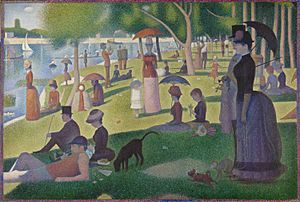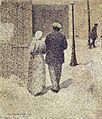Post-impressionism facts for kids
Post-Impressionism is a name for a type of art that came after Impressionism in France. It started in the late 1800s. A British art expert named Roger Fry first used the word in 1910. He organized an art show called Manet and the Post-Impressionists.
Post-Impressionist artists were influenced by the Impressionist painters. The word "Post-" means "after". So, Post-Impressionist painting came after Impressionist painting. These artists took ideas from Impressionism but wanted to try new things.
They still painted real-life scenes with bright colours. They often used thick paint. But they also added their own ideas. Some used geometric shapes, others changed forms for effect. They sometimes used colours that were not natural.
The main Post-Impressionist painters were Paul Cezanne, Paul Gauguin, Vincent van Gogh, Georges Seurat, Henri Toulouse-Lautrec, and Henri Rousseau. Artists like Picasso and Braque were also Post-Impressionists. However, they are usually called Cubists.
These artists lived in France and knew each other. But they did not work together as a group. They each painted in their own unique way. The Post-Impressionists helped other artists to try new styles. This led to many different types of Modern art in the 20th century.
Contents
Meet the Post-Impressionist Artists
- Paul Cezanne was friends with the Impressionist painters. He showed his art in their exhibitions. But his style became very different over time. He started painting landscapes using flat areas of colour. These "planes" of colour influenced artists like Pablo Picasso and Georges Braque. Their style was called Cubism.
- Paul Gauguin loved to use very bright colours and flat patterns. He often painted people from villages in their colourful clothes. Vincent van Gogh invited Gauguin to live with him to share ideas. But it did not work out well. Gauguin then left France and moved to the island of Tahiti. There, he painted the local people. His ideas about colour and pattern influenced artists like Henri Matisse. This led to a bright style called Fauvism.
- Vincent van Gogh, like Gauguin, used bright colours. His style is very unique. He often put paint on the canvas in short, wavy brushstrokes. Van Gogh struggled with his well-being for much of his life. He never sold a painting during his lifetime. Many believe his painting style was affected by his health. Other artists were inspired by his work. They felt free to "express their feelings" in their art, rather than just painting things realistically. A group called the Expressionist painters were influenced by van Gogh and Gauguin.
- Henri Toulouse-Lautrec was a wealthy man who lived in Paris. He was often sick and had a disability. He painted people he met in nightclubs, cafes, and theatres. He was a great drawer. Many of his paintings are like drawings made with thin paint. Some are drawings made with pastels. Toulouse-Lautrec made many portraits and scenes of Paris "night-life". He also designed many posters to advertise shows.
- Georges Seurat, like Cezanne, was a friend of the Impressionists. He was interested in how light affects colour. He studied light and experimented with painting pictures using hundreds of tiny dots of bright colour. Seurat's style of painting is called Pointillism.
- Henri Rousseau was another artist who knew the Impressionists. He worked as a toll collector. His friends called him Le Douanier, which means "the customs official". He painted as a hobby. Most of his pictures came from his imagination and looked like dreams. He never had art lessons. His paintings have a child-like quality. Artists who paint like this are called 'naive' artists.
How Post-Impressionism Influenced Art
The Post-Impressionist painters each experimented with the ideas of the Impressionists in different ways. Most of the important art styles of the twentieth century grew out of their work. Even though these painters were not famous during their lives, they became very well-known later. Today, their paintings can sell for millions of dollars.
Related pages
Images for kids
-
Henri Rousseau, The Centenary of Independence, 1892, Getty Center, Los Angeles
-
Poster of the 1889 Exhibition of Paintings by the Impressionist and Synthetist Group, at Café des Arts, known as The Volpini Exhibition, 1889
-
Henri de Toulouse-Lautrec, Portrait of Émile Bernard, 1886, Tate Gallery London
-
Camille Pissarro, Haying at Eragny, 1889, Private Collection
-
Paul Cézanne (1839–1906)
-
Henri Rousseau (1844–1910)
-
Vincent van Gogh (1853–1890)
-
Henri-Edmond Cross (1856–1910)
-
Georges Seurat (1859–1891)
-
Théo van Rysselberghe (1862–1926)
-
Paul Signac (1863–1935)
-
Henri de Toulouse-Lautrec (1864–1901)
-
Paul Sérusier (1864–1927)
-
Édouard Vuillard (1868–1940)
See also
 In Spanish: Posimpresionismo para niños
In Spanish: Posimpresionismo para niños



























